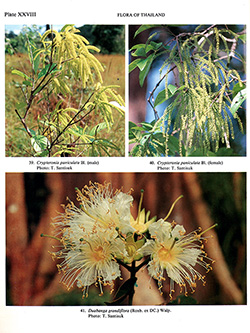e-Flora of Thailand
Volume 5 > Part 4 > Year 1992 > Page 435 > Sonneratiaceae > Duabanga
Duabanga grandiflora (Roxb. ex DC.) Walp.wfo-0000657551
Reperf. 2: 114. 1843; Back. & Steenis in Fl. Males., Ser. 1, Spermat. 4: 289. 1951; Cuong in Fl. C.L.V. 4: 204. Pl. 2. 1965; Jayaweera, J. Am. Arbor. 48: 96. F. 5, a–g. 1967; Whitmore in Tree Fl. Mal. 1: 444. F. 1. 1972; Fl. Bangladesh 12: 2. 1980.— Lagerstroemia grandiflora Roxb. (Hort. Beng.: 38. 1814, nom. nud.) ex DC., Mém. Soc. Hist. Nat. Genéve 3: 84. 1826. Plate XXVIII: 41.
Accepted Name : This is currently accepted.
Synonyms & Citations :
Description : Tall tree, 15–35 m high; all parts glabrous; young branchlets quadrangular. Leaves oblong to ovate-oblong, 10–24 by 4–10 cm; apex acuminate; base broadly rounded to slightly cordate; lateral veins in 12–28 pairs, widely patent, prominent below, arcuate into intramarginal veins; dark green above, glaucous below; petiole stout, 3–9 mm long. Flowers nocturnal, white, showy, with an offensive smell, 4–7 cm across, in a drooping lax corymb; pedicel stout, 3–4 cm long. Calyx-tube broadly cup-shaped, 1.5–2.4 cm across; calyx-lobes 6(–7), triangular-ovate, 1.2–3 by 0.7–1.4 cm, spreading. Petals 6(–7), ca 4 by 3 cm; claw 2–4 mm long. Stamens ca 50 or more, biseriate; anthers curved, versatile. Capsule ovoid-globose, 2.7–3.4 by 3–4 cm, green turning brown, with persistent calyx-lobes.
Thailand : NORTHERN: Chiang Rai, Chiang Mai, Phrae; NORTH- EASTERN: Nong Khai; EASTERN: Nakhon Ratchasima, Ubon Ratchathani; SOUTH-EASTERN: Chon Buri; SOUTH-WESTERN: Kanchanaburi; CENTRAL: Saraburi; PENINSULAR: Chumphon, Satun, Yala.
Distribution : India (Sikkim and Assam – type), Burma, S China (Yunnan), Indochina, W Malaysia.
Ecology : Occurring sporadically in open, disturbed moist areas, from sea level to ca 1,200 m alt., more frequent in hilly areas on the moist valley slopes. The tree is deciduous or partially deciduous for a brief period.
Vernacular : A (อ้า), kala (กาลา), kho niang (คอเหนียง), lang (ลาง), luk lang (ลูกลาง), sabannga Chang (สะบันงาช้าง), ten (เต๋น), tum aa (ตุ้มอ้า), tum bok (ตุ้มบก), tum lang (ตุ้มลาง), tum ten (ตุ้มเต๋น)(Northern); ko (โก, โก๊ะ), ku (กู), sang-ka (ซังกะ)(Karen-Northern); lin khwai (ลิ้นควาย), taku ka (ตะกูกา)(South- eastern); ka-plong (กาปลอง)(Chong-Southeastern); kradangnga pa (กระดังงาป่า), ngon kai (หงอนไก่)(Southwestern); kha khiat (ขาเขียด), lamphaen (ลำแพน), lamphaen khao (ลำแพนเขา), lamphu khi maeo (ลำพูขี้แมว), lamphu khuan (ลำพูควน), lamphu pa (ลำพูป่า), prong (โปรง), takai (ตะกาย)(Peninsular); ba-ku-mae (บะกูแม), bo-mae (บ่อแมะ)(Malay-Peninsular).
Uses: The wood is grey, streaky and soft; seasons well without warping or splitting. It is used for boxes, planks, canoes, oars and umbrellas.

